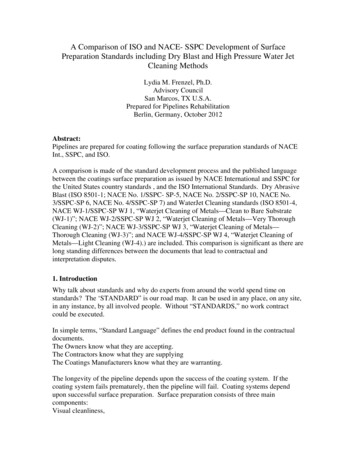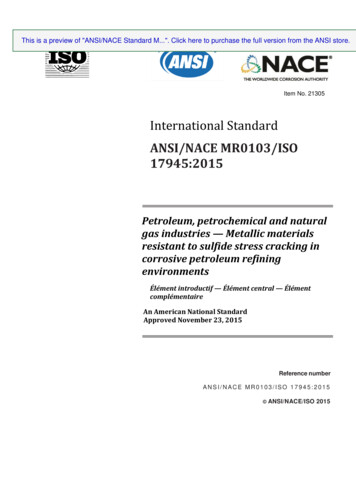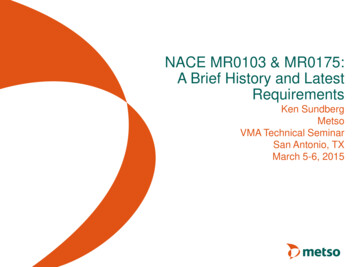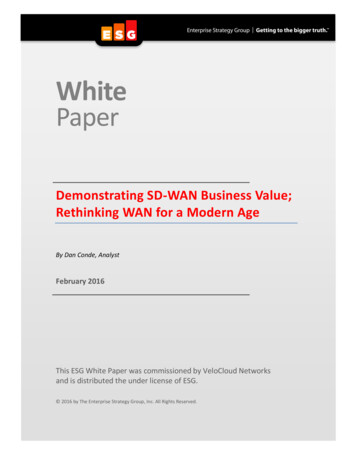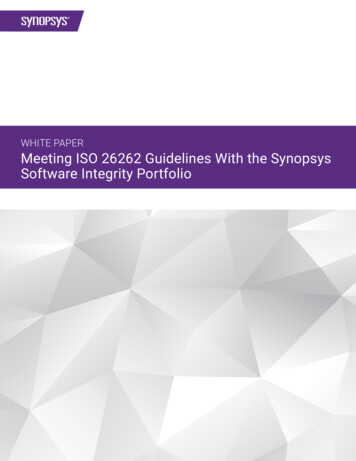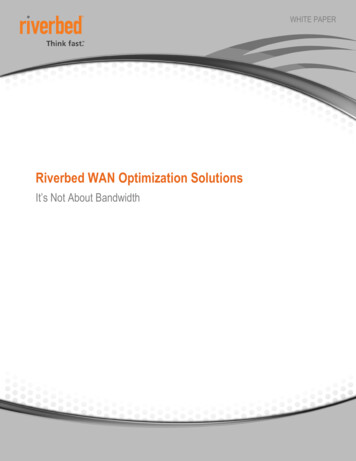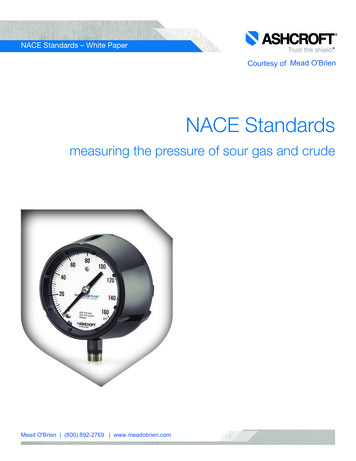
Transcription
NACE Standards – White PaperNACE Standards – White PaperCourtesy of Mead O'BrienNACE Standardsmeasuring the pressure of sour gas and crudeMead O'Brien (800) 892-2769 www.meadobrien.comAshcroft NACE Standards - White Paper1
NACE Standards – White PaperNACE StandardsMeasuring the Pressure of Sour Gas and CrudeEvery mechanically activated pressure instrument relies on anelastic element to bend in response to a pressurized medium.Most often, the element is a metallic “C” shaped or coiled Bourdon tube that attempts to straighten under pressure. Specifiersneed to be especially careful that the chemical composition ofthe excitation medium does not react unfavorably with the instrument’s wetted materials. Measuring the pressure of compressedair or water seldom results in an incompatibility. However, whenoil and gas first come out of the ground, the story can be quite different. Both hydrogen sulfide (H2S) and carbon dioxide (CO2, whencombined with water forms carbonic acid) can exist as unwantedcomponents. Raw petroleum fluids infused with hydrogen sulfideare known as “sour gas” or “sour crude”, and can attack containment materials, causing stress corrosion cracking. This can leadto a breach in the vessel and allow gas or oil to escape into thesurrounding environment. The consequences can be disastrous.HOW IT STARTEDFounded in 1943 by corrosion engineers working in the pipelineindustry, the National Association of Corrosion Engineers set out“To protect people, assets, and the environment from corrosion”.By the 1960s, they had begun to develop control standards thatwould establish appropriate materials for a wide variety of corrosive applications, including oil and gas production and refineryfacilities. In 1993, the organization was renamed “NACE International” after having grown in scope, importance and geography.WHAT DOES NACE SPECIFY?NACE offers over 150 standards that address metal corrosion ina vast number of applications ranging from exposed metal structures to corrosion resistant coatings on railroad cars. For purposes of this overview, the discussion will be limited to the NACEstandards that specifically address corrosion resulting from exposure to sour gas or sour crude. The two primary NACE standardsare MR0103 that applies to refineries, and MR0175 (also adoptedby ISO as 15156) which is directed to oil and gas production. Bothapply to metals only, and do not address plastics or elastomers.Using materials selected in accordance with these NACE standards will reduce the likelihood of failure due to stress corrosioncracking in sour environments.MR0175 / ISO 15156 – 2009: “Materials for Use in H2S ContainingEnvironments in Oil and Gas Production”. This specification hasbeen adopted as a worldwide standard by NACE, ANSI, and ISO.It is divided into three sections, separately addressing general requirements, ferrous alloys, and corrosion resistant alloys as usedin sour oil and gas field applications.MR0103 – 2010: “Materials Resistant to Sulfide Corrosion Cracking in Corrosive Petroleum Refining Environments”. This document addresses the selection of materials in oil and gas refineries.To measure harsh pressure media, it is preferable to use an instrument with compatible wetted parts. However, this choice is limitedby the ability of compatible materials to perform adequately as aBourdon tube. The alternative is to isolate the pressure instrumentfrom corrosive media by installing a diaphragm seal in between.Although offered in a variety of corrosion-resistant materials, notall will be impervious to every combination of application variables. Given the consequences of component failures, the selection of appropriate materials and best practices is paramount. Sowhat are the correct materials? Who will make the determination?Refinery environments are typically less severe than productionenvironments, due to lower chloride concentrations and higherpH levels. As a result, MR0103 tends to be less stringent thanMR0175 / ISO15156.These NACE specifications only consider stress corrosion cracking due to exposure to H2S and other corrosives and do not address general or localized corrosion. Additionally, the standardsrestrict the usage of many alloys by limiting the temperature, pH,and/or composition to which these alloys may be exposed. It isMead O'Brien (800) 892-2769 www.meadobrien.comAshcroft NACE Standards - White Paper2
NACE Standards – White Paperthe responsibility of the specifier to select an appropriate instru-Laboratory Testingment or component with the correct features for their particularLaboratory tests that recreate applicable test variables definedset of variables to ensure NACE compliance.in the standard will ensure that the tested materials and components will be compatible. Certified testing labs with experience inthis type of testing will establish and execute an appropriate testprotocol.Field ExperienceComponents that have been in service and have not succumbedto corrosion over an appropriate period of time may be documented and considered a proof test for the specific application.SO WHAT MATERIALS CAN BE USED?Depending upon the severity of the corrosive conditions, differentmaterials may be safely employed. In these cases, metal choicesare a function of cost. While Hastelloy C22/C276 or titaniummay be the best choice to ensure unquestionable compatibility,THE VARIABLESthe price for these specialized metals would add unnecessaryTemperaturecost to facilities handling less harsh media.The temperature of the process medium can have a significantThe list and chart below provide a simplified reference for choiceseffect on the ability of any material to resist corrosion. Stainlessof metals tested and used by Ashcroft as elastic elements andsteels are especially sensitive to temperature, especially whenother wetted parts, (in compliance with NACE MR0175):chlorides are presentFavorable ConditionsChemistry(Low concentrations of hydrogen sulfide and chlorides)The presence of hydrogen sulfide, chlorides (salts, often from Stainless Steels (316 is most commonly used)subterranean salt deposits) and carbon dioxide can all contribute Alloy 20to corrosion. The quantities and combinations of these com-Moderate Conditionspounds will also be a factor in determining the adequacy of spe-(Where higher temperatures can begin to hasten corrosion,cific metals.depending on the chemistry of the media)pH Super Duplex SteelsWhether the pressure media are acid or base is another consid- Alloy 400 (Monel )eration. Low pH (acids) can increase corrosion rates and causeExtreme Conditionshydrogen liberation that can result in embrittlement of the metal.(High concentrations of hydrogen sulfide, chlorides and acidsMetallurgical Conditionand high temperatures pose a risk of stress cracking due toHardened metals are more susceptible to stress fractures. An-corrosion. Titanium and Nickel, Chromium and Molybdenumnealed metals are softer and less likely to crack, but have a loweralloys are best, but most expensive)tensile strength. Hastelloy C22/C276ASSURING THAT A COMPONENT IS COMPLIANT Alloy 400 (Monel )To ensure that a component meets the NACE standards, deter- Titaniumminations can be based on:Meeting the Conditions Specified in the StandardBy following the NACE recommendations, all requirements willbe met. When in doubt, use materials that are compliant with theworse-case application.Mead O'Brien (800) 892-2769 www.meadobrien.comAshcroft NACE Standards - White Paper3
NACE Standards – White PaperRead our product information page about NACE standards andmaterial selection.www.ashcroft.com/productinformation eum-refining-nacemro175-mro103-ash-pi-60c.pdfOur Critical Applications Solutions Experts (CASESM) areavailable to help you select the appropriate materials whenspecifying Ashcroft mNACE specifications are detailed and can be complex when addressing combinations of variables. Regardless, they are important and necessary requirements for the safe measurement andcontrol of raw, corrosive gas and oil that have been extractedfrom the ground or seabed.To learn more about NACE specifications, visit www.nace.org.This article was written by John Carissimi (Media Manager) andJeremy Payne (Materials and Testing, Engineering Manager) ofAshcroft Inc. With over 160 years of experience, Ashcroft manufactures pressure and temperature instrumentation, includingmedia isolation devices, for a wide variety of industries throughout the world, including oil and gas processes. For more information about Ashcroft products, please visit www.ashcroft.com orcall 800/385-0635.These pages have not been reviewed/approved by NACE International and are offered as an introductory reference only. Specifiers and users should refer to the published NACE specificationsto establish the correct materials for their applications. Ashcroft Inc.NACE is a registered trademark of NACE International.Monel is a registered trademark of Special Metals Corporation.Hastelloy is a registered trademark of Haynes International, Inc.MeadO'Brien (800)892-2769 www.meadobrien.comAll specificationsare subjectto changewithout notice.ashcroft.comAll sales subject to standard terms and conditions.info@ashcroft.com 2016 Ashcroft Inc. Rev. B 05/27/161.800.328.8258Ashcroft NACE Standards - White Paper4
NACE Standards – White PaperMead O'Brien (800) 892-2769 www.meadobrien.comAshcroft NACE Standards - White Paper5
NACE Standards – White PaperMeadO'Brien (800)892-2769All specificationsare subjectto changewithout notice. www.meadobrien.comashcroft.comAll sales subject to standard terms and conditions.info@ashcroft.com 2016 Ashcroft Inc.1.800.328.8258Ashcroft NACE Standards - White Paper6
The two primary NACE standards are MR0103 that applies to refineries, and MR0175 (also adopted by ISO as 15156) which is directed to oil and gas production. Both apply to metals only, and do not address plastics or elastomers. Using materials selected in accordance with these NACE stan-dards will reduce the likelihood of failure due to stress corrosion cracking in sour environments. MR0175 .
